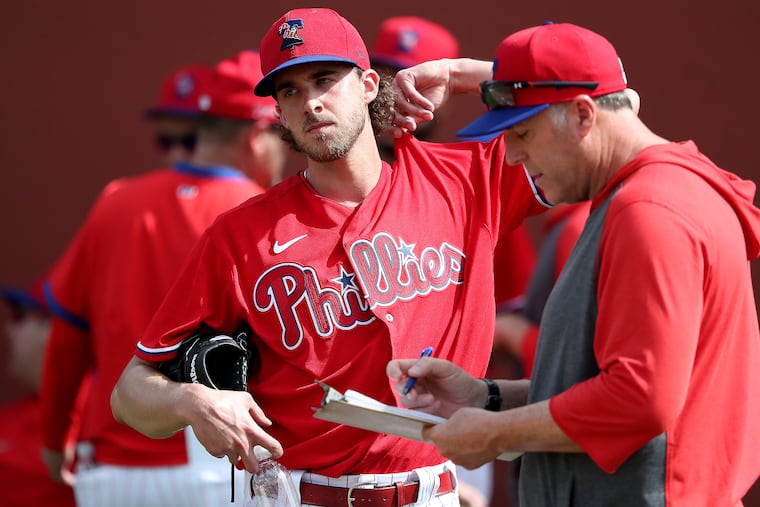Aaron Nola prefers new Phillies pitching coach Bryan Price over data-driven Chris Young
“He knows how to run things,” Nola said of Bryan Price, “and he’s not going to change how the game is played.”

CLEARWATER, Fla. — Aaron Nola’s first impression of the Phillies’ new pitching coach: He isn’t the old pitching coach.
That’s a good thing, by the way, as far as Nola is concerned. The Phillies ace is on his fourth pitching coach in as many seasons and, well, let’s just say that he preferred the traditional approach of experienced Bob McClure in 2017 and Rick Kranitz in 2018 to the data-driven methodology of newbie Chris Young last year.
It was welcome news, then, to Nola when the Phillies hired Bryan Price in October. A 57-year-old former big-league pitcher, Price coached Jamie Moyer in Seattle and Cy Young Award-winning Brandon Webb in Arizona. He was the first big-league pitching coach for both Felix Hernandez and Max Scherzer and one of Randy Johnson’s last. He has two decades of experience in the job.
“He knows how to run things,” Nola said Sunday, “and he’s not going to change how the game is played.”
Standing outside the clubhouse after a workout at the Carpenter Complex, Nola spoke as softly as usual but seemed to choose his words more carefully. He isn’t the type to make excuses and certainly not headlines, and he never explicitly mentioned Young’s name.
But he also believes deeply that the Phillies got away from core principles of pitching last season with Young leading a staff for the first time.
"Kranny is one of the best pitching coaches I've ever had because he simplified things," Nola said. "Bob McClure simplified things to the best because he's old-school. That was your plan, especially in bullpens. We had a bad game, you'd get back to basics and go from there. I don't see too much of a difference with Bryan in that aspect."
Young had a scouting background two years ago when the Phillies enlisted him as assistant pitching coach. His approach appealed to then-manager Gabe Kapler, a devotee of data who inherited Kranitz from predecessor Pete Mackanin’s staff. After the 2018 season, the Phillies promoted Young and fired Kranitz, who promptly got hired by the Atlanta Braves.
While Young had a knack for studying video and analyzing numbers to identify areas that could be improved, explaining them to pitchers and helping them implement changes were another matter. The Phillies finished with a 4.53 team ERA, 11th in the 15-team National League, and 1.37 walks/hits per inning pitched, a spike from a 4.14 ERA and 1.29 WHIP in 2018.
Young emphasized throwing four-seam fastballs at the top of the strike zone, a philosophy that didn’t suit many Phillies pitchers, notably right-hander Zack Eflin. The lack of success also didn’t help to build trust between them and Young.
“The game has evolved, I think, to where at times we have all this data," Price said. "I still believe fundamentally that pitchers need to command the strike zone, they have to pitch aggressively, they have to control the count, and they have to pitch to their strengths.”
Indeed, based on his early interaction with Price, Nola is confident that the one-style-fits-all tack will be scrapped. He recently had a long chat with Price about Moyer’s success with a fastball that barely cracked 80 mph and came away realizing that Price values diversity in pitching styles.
“It’s so important because not everybody’s the same,” Nola said. “Not everybody can throw fastballs up and blow it by guys. I can [do it] maybe once, but if I do it again, [the hitter] will time it up. The whole point is to change eye levels, change speeds.
“Ground balls still work. Balls down in the zone still work. I don’t think that’s ever going to get away from the game. As kids we all learned, ‘Throw the ball down, throw the ball at the knees, get ground balls early in the count. Don’t try to strike the guy out at the beginning of the at-bat when it’s an 0-0 count.’ That’s what Bryan stresses.”
Nola made 34 starts and pitched 202 1/3 innings last season, the second year in a row that he topped the 200-inning mark. But his ERA rose from 2.37 in 2018, when he finished third in the NL Cy Young voting, to 3.87.
Looking back, Nola started slow (6.84 ERA through five starts) and finished poorly (6.51 ERA in September). In 24 starts in between, he posted a 2.89 ERA and was among the best pitchers in the league.
Maybe Price can help shorten those periods of struggle, just as Kranitz did in 2018. At the very least, it seems Nola will feel more comfortable with Price’s input and advice than he did with Young’s.
“I know he’s super-knowledgeable,” Nola said. “Just to have him, especially in bullpen sessions, maybe try something and say, ‘You look like so-and-so. I did this with him and it might work for you.’ Pitching ain’t simple, but to simplify it is what we need to do, to not overthink things, to not get in that big of a head-slump. He’s not going to change how pitching’s always been throughout however long baseball’s been baseball.”
And for Nola, that will be a welcome change.